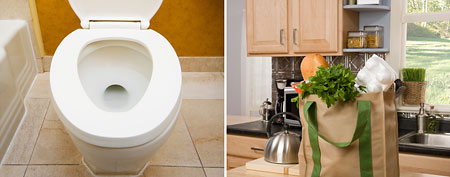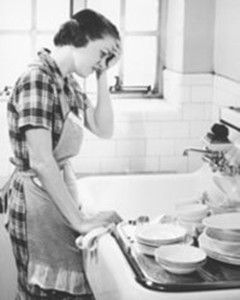Which is Dirtier: Your Kitchen or Your Toilet Seat?
你家的厨房和浴室,哪个更脏?

 |
"In most cases, it's safer to make a salad on a toilet seat than it is to make one on a cutting board," says Dr. Charles Gerba (a.k.a. Dr. Germ), a microbiologist and professor at the University of Arizona in Tucson. "People disinfect their toilet seats all the time, but they don't realize that they really need to pay attention in the kitchen too." Since 1973, he's been studying the hidden bacteria lurking in American homes, and his findings should influence your behavior when it comes to storing a toothbrush (in the medicine cabinet) and how to flush a toilet (lid down). Here, Dr. Germ identifies the top five dirtiest spots in the kitchen and gives advice on how to banish nasty germs.
“在大多数情况下,在马桶盖上制作沙拉要比在切菜板上安全的多,”亚利桑那大学的微生物学家和专家Germ博士说道。人们总是记得给马桶消毒,但是他们却没有意识到厨房也需要更多的关注。自1973年起,Germ博士就一直在研究隐藏在美国家庭中的细菌,而他的发现也许会影响你的行为哦!要将牙刷放进药箱里,要将马桶盖盖上再冲水。今天,Germ博士就和大家一起识别厨房中最脏的5个地方并告诉大家如何除菌。
1. Sponges and Dishcloths 洗碗绵和抹布
"We did a survey collecting 1,000 sponges and dishcloths in kitchens, and about 10 percent had salmonella. They get wet and stay moist, so bacteria grow like crazy. The most E. coli and other fecal-based bacteria in the average home are on a sponge or cleaning cloth."
DR. GERM'S ADVICE: "Replace dishcloths every week and throw the sponge into the dishwasher or microwave it on high for 30 seconds."
我们对收集的1000块洗碗绵和抹布进行了分析,其中约有10%的洗碗绵和抹布带有沙门氏菌。由于这些洗碗绵和抹布经常是潮湿状态,这样就很容易滋生细菌。普通家庭中的多数大肠杆菌与其他残菌均来自洗碗绵或者抹布。
Germ博士建议:每周更换抹布并将洗碗棉丢进洗碗机或者微波炉高温消毒30秒。
2. Sink 洗涤盆
"There's more E. coli in a kitchen sink than in a toilet after you flush it. The sink is a great place for E. coli to live and grow since it's wet and moist. Bacteria feed on the food that people put down the drain and what's left on dishes in the sink. That's probably why dogs drink out of the toilet--because there's less E. coli in it," says Dr. Germ.
DR. GERM'S ADVICE: "Clean the sink basin with a disinfectant product made for the kitchen. Vinegar and lemon juice can clean some bacteria, but they can't clean really bad pathogens, so the Environmental Protection Agency doesn't recommend using them as an alternative."
Germ博士说“洗涤盆上残留的大肠杆菌要比冲洗后的马桶还要多。洗涤盆内潮湿的环境很适宜于大肠杆菌滋生并生长。细菌依靠人们倒入下水道和残留在洗涤盆上的食物残渣为生。那或许就是为什么狗会喝从马桶溢出的水, 因为马桶水的大肠杆菌含量较少。”
Germ博士建议:使用厨房专用消毒剂清洗洗涤盆。虽然醋和柠檬汁也可以消灭一些细菌,但是它们并不能消灭坏病原体,所以环境保护署并不建议使用此法。
3. Cutting Board 切菜板
"In most cases, it's safer to make a salad on a toilet seat than it is to make one on a cutting board. There're 200 times more fecal bacteria from raw meat on the average cutting board in a home than a toilet seat. Most people just rinse their cutting board, but poultry and raw meat can leave behind salmonella and campylobacter." The latter bacteria, which can come from eating raw meat, is one of the most common causes of food-borne illness, according to the FDA.
DR. GERM'S ADVICE: "Use one cutting board for meats and another one for vegetables, so you don't get cross-contamination. Boards can be cleaned with a kitchen disinfectant or put it in a dishwasher." As to whether you should buy a wood or plastic cutting board: "We used to always recommend using plastic cutting boards, but wood seems to have antimicrobial resins, so it's a toss-up."
“大多情况下,在马桶盖上制作沙拉要比在切菜板上安全的多。家里的切菜板上会残留有切生肉留下的细菌, 而细菌数量是马桶座上细菌数的200多倍。大多数的人都只是冲洗他们的切菜板,但是,家禽肉和生猪肉会在切菜板上留下沙门氏菌和弯曲杆菌。 ”据食品与药物管理局称,因食用生猪肉而感染的弯曲杆菌是食源性疾病最常见的病因之一。
Germ博士建议:切肉板和切菜板分开使用,这样就可以避免交叉污染。切板可以用厨房消毒剂来清洗或者放入洗碗机。至于你是应该买木质切板还是塑料质切板?我们过去总是建议使用塑料切板,但是木质的似乎进行了抗菌处理,那么,就投币决定吧。
4. Bottom Shelf of the Refrigerator 冰箱最底层
"When we looked at refrigerators, the bottom shelf tends to have the most bacteria, because moisture and condensation drip down from the upper shelves. People often put produce on a bottom shelf and defrost a meat product above it."
DR. GERM'S ADVICE: "Wipe down the bottom shelf every two or three weeks with a disinfectant cleaner that's made for the kitchen. To avoid cross-contamination, put raw meat on the bottom shelf and tuck raw produce into a drawer away from everything else."
说到冰箱,冰箱最底层往往是细菌最多的地方,因为有水分和凝结物从上一层滴下。人们常常将食物冻在最底层,然后在上面的保鲜层解冻肉。
Germ博士建议:每2,3个星期就用厨房专用除菌剂将最底层上上下下擦拭干净。为避免交叉污染,最好将生肉放在冷冻柜中并与其他食品分开盛放。
5. Kitchen Countertops 厨房工作台
"Kitchen countertops tend to be the dirtiest near the sink area because people wipe them down with sponges and cleaning cloths that have E. coli and other bacteria. The sponges and cloths just spread the germs all over the countertops."
DR. GERM'S ADVICE: "Use a disinfectant kitchen cleaner and finish off by drying the countertop with a disposable paper towel. Paper towels are great because they absorb a lot of the moisture and bacteria and you can just throw them away."
厨房工作台往往是洗涤盆附近最脏的地方,因为人们都是用带有大肠杆菌和其他细菌的洗碗棉和抹布擦拭。洗碗棉和抹布正好将细菌散布在台面上。
Germ博士建议:使用厨房专用消毒剂擦拭台面,然后用一次性纸巾将台面擦干。纸巾就是如此强大,因为他们可以吸收大量水分和细菌,然后你就可以把它们扔了。







